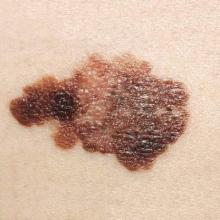Treatment with vemurafenib may result in severe skin toxicity, and dabrafenib appears to be useful in patients who discontinue vemurafenib due to such toxicity, according to a retrospective analysis of the cohort.
About a quarter (26%) of 131 melanoma patients treated in real life conditions with the BRAF inhibitor vemurafenib developed grade 3-4 skin toxicity, and 44% (34) of those patients permanently discontinued treatment, corresponding to 11% of the overall cohort, Dr. Lucie Peuvrel of Nantes (France) University Hospital and colleagues reported in Journal of the European Academy of Dermatology and Venereology.
Discontinuations were mainly due to rash and classic adverse skin reactions, including Stevens-Johnson syndrome, drug reaction with eosinophilia, and systemic symptoms, whereas reactions involving only photosensitivity or cutaneous carcinomas rarely resulted in treatment adjustment; 14 of the remaining 19 patients with grade 3-4 toxicity who continued treatment had no dose adjustment, and 5 had a dose reduction.
Clinical or biological abnormalities occurred in 94% of those with grade 3-4 rashes, the investigators noted (J Eur Acad Dermatol Venereol. 2016 Feb;30[2]:250-7).
Study subjects were patients with a mean age of 60 years who were treated with vemurafenib for melanoma between November 2010 and December 2014. Grade 3-4 skin toxicity that emerged within the first 4-8 weeks of treatment was significantly associated with prolonged overall survival; severe skin rashes also were associated with prolonged median overall survival. Of seven patients who switched to dabrafenib due to their skin reaction, only one experienced recurrence of the reaction.
Vemurafenib, which is approved for the treatment of unresectable stage III-IV BRAF mutant melanoma, is commonly associated with skin toxicity, with severe cases occurring only rarely; the impact of severe forms of toxicity on treatment and patient outcomes was unknown, the investigators said.
The current findings reaffirm that vemurafenib is commonly associated with skin toxicity, but rarely with severe cases. Severe skin adverse reactions permanently preclude use of vemurafenib, but dabrafenib – the only other BRAF inhibitor with market authorization for unresectable stage III-IV BRAF mutant melanoma – “seems to be beneficial in case of vemurafenib-induced skin intolerance,” they noted, adding that for other skin toxicities, including photosensitivity and cutaneous carcinoma, treatment adjustment is generally not required, and that treatment resumption at a reduced dose should be considered after skin improvement in patients with rashes.
The finding of increased survival in cases involving severe skin toxicity that emerges within 4-8 weeks of treatment initiation should be confirmed in other studies, Dr. Peuvrel and associates said.
The authors reported having no conflicts of interest.


